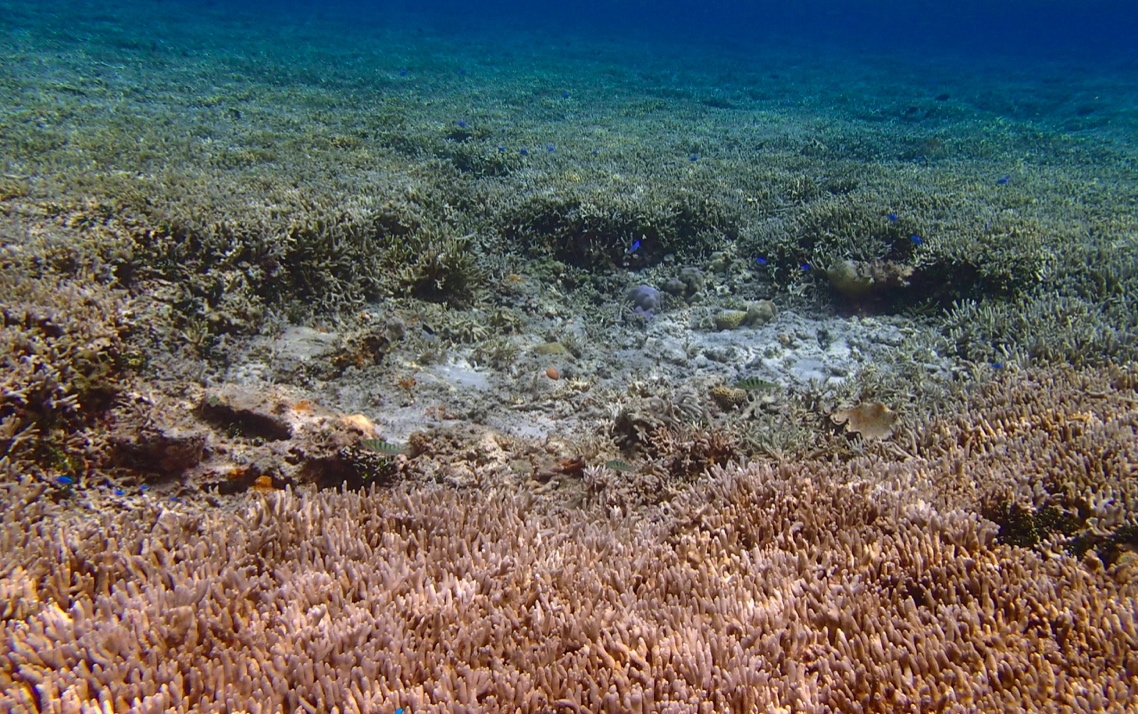
SHATTERED CORALS Fragile corals, living organisms that also provide shelter to fish and other marine creatures, take decades to grow but can be destroyed in mere seconds through harmful fishing methods by poachers and illegal fishermen. Scientists say declining fish catch is a sign of continuing reef destruction resulting in lostmarine resources valued at about P33 billion yearly.—PHOTO COURTESY OF DR. DEO FLORENCE ONDA OF THE UNIVERSITY OF THE PHILIPPINES’ MARINE SCIENCE INSTITUTE
MANILA, Philippines — The Philippines is losing about P33.1 billion annually from the damaged reef ecosystems at Panatag (Scarborough) Shoal and the Spratly Islands mainly due to China’s reclamation activities and illegal fishing operations, according to Filipino marine scientists.
Deo Florence Onda, a scientist with the University of the Philippines’ Marine Science Institute (UP MSI), on Wednesday said the figure, while already staggering, was a “conservative estimate,” considering the complex marine biodiversity of the country.
“The value includes all the services that we get from the coral reefs like climate regulation and the benefits we get from the ecosystem,” he said at a forum organized by conservation group Oceana Philippines.
Onda said the amount of losses was determined using the baseline value of $353,429 (P18 million) per hectare per year for coral reefs that was arrived at in a study by a Dutch information and analytics company.
While the reefs remain damaged, the country loses that much annually, he said.
The study, “Global estimates of the value of ecosystems and their services in monetary value,” was done in 2012 by Elsevier, one of the world’s major providers of scientific, technical and medical information.
Satellite images showed the damaged reef ecosystems at Panatag covered 550 hectares and 1,300 ha in the Spratlys group.
Unchecked by gov’t
Maritime law expert Jay Batongbacal said the figures did not include areas not visible to satellites.
While the Chinese are not the only poachers in Philippine waters, the mass harvesting of giant clams by Chinese fishermen and China’s massive reclamation to build seven artificial islands caused the most severe damage.
If these activities remain unchecked by the government, Onda said the decline in the country’s fisheries output would continue and could threaten the country’s food security.
Batongbacal said poaching had also led to falling fish catch for the Philippines while China’s production was going up.
“We aren’t joking when we say that if we do not stop Chinese fishers from our seas, they will likely drain all our marine resources in just a few years,” he said. “In Scarborough Shoal, they even destroy the reefs themselves … If this continues, the shoal would be completely wiped out in five years.”
Human rights lawyer Chel Diokno said the government had been “remiss in its constitutional obligation to protect our marine resources and fisherfolk.”
He cited the ramming and sinking of a Filipino fishing boat by a Chinese trawler, which then abandoned 22 Filipinos struggling in the water before they were rescued by Vietnamese fishermen.
Interconnected
Onda said the country’s various ecosystems were interconnected and it would be unwise to focus on just one.
The scientist was reacting to remarks made by Supreme Court Associate Justice Andres Reyes Jr. during oral arguments on Tuesday on a petition for a writ of kalikasan seeking protection for the country’s marine resources, particularly in the West Philippine Sea.
Kalayaan Palawan Farmers and Fisherfolk Association filed the petition.
Reyes said the government did not have the resources to guard all the country’s shoals, suggesting instead to spend the money it had to rehabilitate the heavily polluted Pasig River.
“If we want to understand how we live,” Onda said, “we need to understand the entirety of the ecosystem. There is a strong connection between the land and the seas. Not protecting one will affect the other.”
Issues concerning the environment and natural resources should not be “compartmentalized” as there are many Filipinos who depend on these ecosystems for food and livelihood, he added.
Department of Fisheries, Oceans
“We have been treating the environment separately, but in fact, we should be treating it as one unit. As a decent human being, I think it should not be a question [of whether] we should protect it,” he said. “We should not [have to choose] on what we should protect and not.”
In a statement presented at the Oceana forum, UP MSI scientists said they supported the creation of a single government agency to oversee the use and protection of the country’s waters.
“As the Philippines transitions to blue economy, we call on the creation of a separate Department of Fisheries and Oceans that will be mandated to study, utilize, manage and protect the largest ecosystem and future biggest contributor to the Philippine economy—our oceans and seas,” the statement said.
According to the World Bank, blue economy is the sustainable use of ocean resources for economic growth, improved livelihoods and jobs while preserving the health of the ocean ecosystem.
For better coordination
Fisheries management is currently under the Bureau of Fisheries and Aquatic Resources, which is under the Department of Agriculture, but marine protection is under the Biodiversity Management Bureau of the Department of Environment and Natural Resources.
“If it’s [all] under one agency, then perhaps the coordination can be better because you are not only considering resources in terms of economics, such as fisheries, but you are also considering the ocean as an ecosystem,” Onda told reporters.
“The government’s management policies, both in terms of ecological and economic [concerns], will jibe together under one agency,” he added. “There are a lot of services that our oceans can offer, and we still have not maximized that.”
Citing a 2018 report by Partnerships in Environmental Management for the Seas of East Asia, Onda said the ocean economy contributed to some 7 percent of gross domestic product.
That is a conservative figure as more than half of the country’s population live in coastal communities and a vast majority of Filipinos rely on marine resources for various needs, he added.

